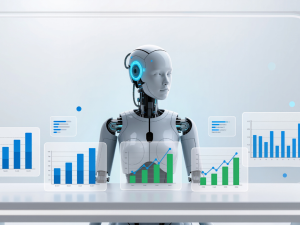The New “Assistant” in the Classroom
Not long ago, a “teaching assistant” usually meant a grad student sitting in the back row, ready to run office hours or grade papers. Fast-forward to today, and your new teaching assistant might not be a person at all. It could be an AI chatbot that answers questions at 2 a.m., marks multiple-choice quizzes instantly, or even generates study guides tailored to your learning style.
The idea sounds futuristic, but it’s already happening. Universities and schools are quietly experimenting with AI teaching assistants (AI TAs). For some students, they feel like lifesavers, always available, never tired, and surprisingly resourceful. For others, they’re another notification, another app, another voice in an already crowded digital classroom.
So the question stands: are AI teaching assistants genuinely helpful guides, or are they edging into digital overload?
Why AI Teaching Assistants Are Showing Up Everywhere
The rise of AI in education isn’t random. It’s the product of a few major forces converging:
- Scalability: Institutions face larger classes and tighter budgets. AI assistants promise to handle repetitive tasks at scale.
- 24/7 Availability: Students don’t just learn from 9–5. AI offers on-demand support any time, any place.
- Personalization: In an era where Spotify recommends your playlists and Netflix knows your taste, students expect their education to feel tailored too.
- Pandemic Push: Remote learning normalized digital tools, making AI adoption feel like the natural next step.
Put simply, AI TAs arrived because the demand for flexible, tech-driven support was impossible to ignore.
Helpful Guide Aspects of AI Teaching Assistants
When AI is at its best, it feels less like a replacement and more like a digital sidekick. Here’s where the tech shines:
Automation at Scale
Grading multiple-choice tests, tracking attendance, scheduling reminders. These are tasks that eat up hours of teacher time but don’t really require human judgment. AI can handle them seamlessly.
This brings us to a common student curiosity: “How can AI be used as a teaching assistant?” The short answer is: by automating the background noise. Teachers then spend less time managing logistics and more time engaging with students.
Personalized Learning Paths
AI systems adapt to your strengths and weaknesses in real time. Struggling with algebra? An AI TA can push extra practice your way. Flying through a reading assignment? It can fast-track you to higher-level material.
The beauty of this approach is that no two students get the same path. This personalization was once impossible in classrooms of 30, 50, or even 300 students. Now it’s a click away.
Data-Driven Insights for Teachers
One of the biggest promises of AI is in the data it generates. By tracking performance trends, AI can flag when students are slipping before they fail. It can also highlight which teaching methods resonate most.
This connects to another student-centered question: “How to use AI to reduce workload?” For teachers, the answer is simple. AI reduces the grunt work so they can focus on mentoring, designing engaging lessons, and guiding students individually.
Enhanced Accessibility & Inclusivity
For students with disabilities or language barriers, AI can be transformative. Text-to-speech, instant translations, and adaptive interfaces break down barriers that once kept some learners at the margins.
In practice, that means a student with dyslexia can have texts read aloud instantly, or a newcomer in an English-speaking class can access real-time translation without waiting for human help.
24/7 Student Support
Traditional teaching assistants have office hours. AI assistants never clock out. Whether you’re cramming at midnight or reviewing before an early morning exam, an AI teaching assistant is just a message away.
Here’s where another common question slips naturally in: “How does AI help in digital assistant?” For students, it’s the difference between waiting for help and getting it immediately. That round-the-clock availability makes AI feel less like a tool and more like a safety net.
The Flip Side: When AI Adds to Digital Overload
For every “aha” moment with AI, there’s a student rolling their eyes at an incorrect answer or worrying about whether they’re relying on the tech too much.
Accuracy and “Hallucinations”
AI has a confidence problem. It can generate answers that sound right but are flat-out wrong known as “hallucinations.” For students, this can be frustrating or even harmful if they don’t double-check sources.
Overreliance and Decline of Critical Thinking
If AI always has an answer, why bother thinking deeply? That’s the slippery slope. Students who lean too heavily on AI risk weakening their own problem-solving skills. Education is supposed to train curiosity and resilience, not just provide shortcuts.
Academic Integrity Concerns
AI makes plagiarism temptingly easy. Essays, assignments, even discussion posts can be machine-generated in seconds. That raises ethical concerns for students and logistical nightmares for institutions.
Here’s where another relevant question emerges: “What is the best AI assistant for teachers?” The answer isn’t about which tool generates flashier content, it’s which one supports academic honesty. The best AI for teachers is one that helps students learn, not cheat.
Teacher Supervision Is Non-Negotiable
Especially in K–12 settings, AI without supervision is risky. Students need guidance on when and how to use the tech responsibly. Teachers don’t disappear in this new model; if anything, their mentorship becomes more crucial.
Implementation Hurdles
AI sounds exciting, but integrating it into schools is expensive, time-intensive, and often uneven. Without proper training, the technology can end up underused or misused.
So, Helpful Guide or Digital Overload?
The truth sits somewhere in the middle. AI teaching assistants can be game-changing when integrated thoughtfully, but overwhelming when dumped into classrooms without strategy.
- As a guide, they automate tasks, personalize learning, expand access, and provide nonstop support.
- As an overload, they risk spreading misinformation, encouraging shortcuts, and creating screen fatigue.
The line between the two comes down to how educators and institutions implement the technology. AI needs to complement, not replace, the human side of teaching.
Students Role: Using AI Without Losing Themselves
For students, the responsibility is just as real. To avoid digital overload while reaping the benefits, consider these principles:
- Process > Product: Use AI to brainstorm, organize, or practice not to do the work for you.
- Trust, but verify: Always double-check AI outputs against reliable sources.
- Stay human: Lean on curiosity, creativity, and critical thinking skills AI can’t replace.
AI may be 24/7, but so are distractions. Knowing when to log off is as much a part of digital literacy as knowing how to log on.
Closing Reflection
The rise of AI teaching assistants signals a turning point in education. For the first time, students can access instant, personalized, and tireless support at scale. But with that power comes risk: misinformation, overreliance, and blurred lines of academic integrity.
So the question isn’t whether AI belongs in the classroom, it’s whether students and teachers can build the guardrails to make sure it helps more than it harms.
And maybe that’s the test for this generation of learners: will AI teaching assistants become trusted guides, or just another layer of digital noise?






